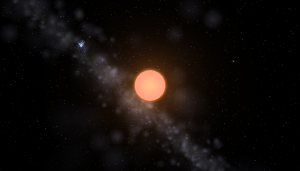Blog
Grandmother Star
7 August 2019
 Tyrogthekreeper at en.wikipedia, (CC BY-SA 3.0)
Tyrogthekreeper at en.wikipedia, (CC BY-SA 3.0)Five billion years ago, a cloud of gas and dust light years across began to collapse under its own weight. Clumps began to form, squeezing together until they were dense and hot enough for hydrogen to start fusing into helium. One of those clumps was destined to become the Sun and its planetary system, including all of us.
The ancient cloud that gave birth to our Sun was itself the remnant of fallen stars. These large stars formed from an even older cloud of gas, fused hydrogen and other elements in their core, then exploded in brilliant supernovas. We know this because the Sun and her planets are rich in elements such as carbon, oxygen and iron. Our Sun has more than a thousand Earth-masses of iron, for example. These elements were not formed by the big bang. They only form in the furnace cores of stars. Since the Sun is rich in iron, we know it arose from the ashes of older stars.
The stars that died to produce our Sun also rose out of the ashes of earlier stars. Our Sun has too much iron to be formed in a single generation of stars. The progenitor stars of our Sun must have formed from iron enriched gas, so there must have been even earlier stars. Tracing back this history, there must have been a first generation of stars. These would have formed only from the hydrogen and helium from the big bang. Grandmother stars formed at the dawn of time.
One way we can determine the generation of a star is to measure the amount of iron a star has. This measure is known as metallicity, the fraction of iron mass vs the total mass of the star. We can determine it by observing the spectrum of light from a star. Iron emits a specific spectrum, and we can see that pattern in distant stars. With each generation of stars, more iron is cast off as gas and dust in interstellar space. So with each generation the metallicity of stars increases. Our Sun has a fairly high metallicity, and at an age of five billion years, it is a relatively young star.
Our Sun is expected to live about ten billion years. Since the universe is about 14 billion years old, any first generation star the size of the Sun or larger would be long dead. It’s thought that most of the first generation stars were quite large. Huge stellar fireballs that lived a very short life. So we might never observe a first generation star.
But recently, we have observed a star that is a daughter of that first generation.1 It is known as SMSS J160540.18−144323.1, and it is about 33,500 light years away. It’s also currently dying. The star has entered its red giant phase, where its core is desperately trying to fuse heavier elements to keep burning. It’s outer layers have swelled and cooled to a dim red glow. Our star will have the same fate in about 5 billion years.
What makes this particular star exceptional is that its spectrum shows almost no sign of iron. Our Sun has more than a million times more iron than this star. But it isn’t a first generation star, because it does have lots of carbon and other elements lighter than iron. It is exactly what you would expect to see in a second generation star.
The spectrum of this star also tells us something about its progenitor. With such little iron, it must have come from the remnants of a large star. Probably about ten times the mass of the Sun. If it were smaller, much of the iron would have been cast into space from its dying supernova. Much larger, and even much of the carbon would remain trapped in the resulting black hole.
SMSS J160540.18−144323.1 isn’t much of a name for the star. It’s worthy of a better one, for as it ends its life it shows us a bit of our own fate. And in its dying glow it tells the story of our past.
T Nordlander, et al. The lowest detected stellar Fe abundance: the halo star SMSS J160540.18−144323.1. Monthly Notices of the Royal Astronomical Society: Letters, Volume 488, Issue 1, September 2019, Pages L109–L113. ↩︎